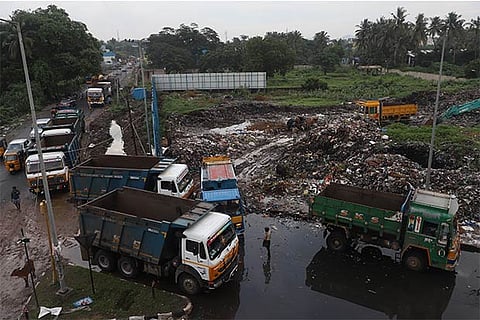

Chennai
While solid biomedical waste generated by government and private healthcare facilities is being monitored in the State, the other major waste — liquid biomedical waste — generated by hospitals and private clinics goes unregulated, claimed healthcare activists. There are no treatment plants in hospitals for safe disposal of liquid waste, they said.
Liquid biomedical waste generated by healthcare facilities include chemical hazardous waste, infectious waste and pharmaceutical liquid waste. Some of the top chemical waste include formaldehyde (obtained from pathology labs, autopsy, dialysis, embalming), mercury (broken thermometers, sphygmomanometer, dental amalgams) and solvents (pathology and embalming). The infectious waste includes laboratory wastes (cultures of infectious agents, cultures from laboratories, biological, discarded vaccines, culture dishes and devices) besides blood and body fluids, while the pharmaceutical waste include discarded, unused and expiry date medicines.
The Biomedical Waste Management Rules 2016 mandates a safe, ventilated and secure location within the premises of a healthcare facility for storage of segregated biomedical waste in coloured bags or containers, to ensure that there is no secondary handling, pilferage of recyclables or inadvertent scattering or spillage by animals. Despite the laws, government facilities lack the infrastructure to treat the waste before transporting it for disposal
The TNPCB annual report regarding biomedical waste generated states that the total number of health care facilities in the State is 4,192. In this, there are 3,972 health care facilities with 1, 35,192 beds. The medical waste generated by bedded hospitals per day in the State is 46.81 tons and non-bedded is 0.55 tonnes. The total amounts to 47.36 tonnes per day and annually, it is 17,286 tonnes.
Healthcare care activities point out that the liquid pathological and chemical waste should be appropriately treated before being discharged into the public sewer systems. “Pathological waste must be treated with chemical disinfectants, neutralised and then should be flushed into the sewage system while the chemical waste needs to be neutralized before being disposed into the sewer,” said Santhana Murthy, another activist.
The liquid waste management should include procedures and practices that prevent discharge of untreated pollutants to the drainage system or to water bodies as a result of the creation, collection, and disposal of non-hazardous liquid wastes, according to him.
In the absence of any monitoring of liquid waste, activists warn that it could lead to serious outbreak of diseases. “The issue we are addressing right now is related to the solid biomedical waste. What about the dangerous liquid biomedical waste? It has a dangerous and deadly potential to contaminate the water bodies and soil if the untreated liquid medical waste is discharged. The liquid medical waste should be treated before letting into the common sewer line. There are no treatment plants in the government and private hospitals. Section F clearly states that the chemical waste shall be pre-treated before mixing with other wastewater,” said Jawaharlal Shanmugam, an activist.
“Liquid biomedical waste can easily get diffused in water bodies and cause major outbreaks. The biomedical waste is usually treated by sodium hypochlorite. But, it is ineffective for the treatment of liquid waste,” he added.
Another activist V Pughazvendan claimed that the government hospitals should maintain a day-to-day biomedical waste management register and display the monthly record of waste generated in terms of category and colour coding on its website. “But the websites of the government hospitals in Tamil Nadu reveals that they do not maintain any such registry,” he says. “The government hospitals ensure the segregation of biomedical waste and then directly transport it to treatment plants through the contractors concerned.”
The solid biomedical waste are collected by the city corporation which is disposed through incinerators in the city. There are no such treatment plants for liquid waste in the hospital. It is let into the common sewer line which connects to the sewage pumping station under the city corporation, where it is treated, Pughazvendan added.
“There are treatment plants for the hospital but not inside the hospital campus,” said a nodal officer, biomedical waste management unit, Rajiv Gandhi Government General Hospital. “Only definite proven infected biomedical waste is treated, while there is no other treatment given to other forms of waste. We do not have any treatment plant currently for liquid biomedical waste or other forms of biomedical waste. The new hospitals or healthcare units might have such infrastructure, but we lack it,” he added.
Many private hospitals in the city differentiate the biomedical waste into hazardous and non-hazardous waste including the human tissue waste. They segregate harsh and non-harsh materials in biomedical waste; there is a treatment plant outside the city to treat the liquid waste in the hospital which will be collected by the concerned authorities. They usually construct a concrete block in the hospital in which the hazardous waste is collected.
“We have effluent treatment plants in the hospital which is being treated for liquid waste from lab and operation theatre. The solid biomedical waste is being taken by the contractor by TNPCB,” said Mathiyalagan, head of General Administration in Fortis Malar Hospital.
When contacted, a senior TNPCB official said, “The state has eight incinerators for solid biomedical waste, but for treating liquid waste from health care facilities, it is let first into a regular sewer line and treated as general sewage, and not as a biomedical waste.”
Types of liquid waste from medical centres
CHEMICALLY HAZARDOUS
INFECTIOUS WASTE
PHARMACEUTICAL LIQUID WASTE (discarded, unused and expiry date medicines)
Send your comments to feedback.dtnext@dt.co.in
Visit news.dtnext.in to explore our interactive epaper!
Download the DT Next app for more exciting features!
Click here for iOS
Click here for Android